STOPPING A
CEREAL KILLER
STOPPING A CEREAL KILLER
BY NATALIE VAN HOOSE
The spots first appeared on the Wappels’ farm in September 2018, late in the growing season. Eric Wappel snapped photos of corn leaves flecked with constellations of tiny, black bumps. A third-generation grower, Wappel was familiar with the symptoms of gray leaf spot and northern corn leaf blight on the 9,000 acres he farms with his father and brother outside San Pierre in northwest Indiana. This, he did not recognize.
The newcomer was tar spot, a once-tropical fungal disease that erupted across the Midwest in 2018. While many farms suffered yield losses that year, Wappel Grain and Herb was spared — infected corn plants still produced high-quality kernels. In 2019, however, Wappel noticed that healthy plants were blanketed with the black spots within a matter of days and soon began to blight and die.
“This thing is killing our corn quick,” he thought.

Eric Wappel compares two different 2019 hybrids. The one on the left was tar spot resistant; the other died early in the season.
In 2021, tar spot struck the farm again, wiping out 50%–60% of yield in the hardest-hit fields where corn was already flagging due to drought, heat and crown rot. “A lot of our corn went from looking good to completely brown within three to four days,” Wappel says. For many fields, “if it didn’t get two passes of fungicide, it was a complete disaster.”
When the Purdue Plant and Pest Diagnostic Laboratory first identified tar spot in dent corn from northwest Indiana in 2015, researchers were surprised, but its presence didn’t immediately set off alarms. That year, the fungus popped up in a few counties in Indiana and north-central Illinois, but caused no yield loss. Scientists thought it would simply be a cosmetic disease.
In 2018, however, tar spot surged across the Midwest, its spread supercharged by rain and humidity. In Indiana, growers in 38 counties saw their yields shrink by 20–60 bushels per acre, potentially a loss of 25%, erasing their profit margins.
Darcy Telenko, assistant professor in the Department of Botany and Plant Pathology and Extension field crop pathologist, received calls from concerned Indiana growers. Fields that should have remained green for another month were withered and brown.
“Over time, I think we built up inoculum [spores of the pathogen], and then we had the perfect weather conditions in 2018 to cause it to explode,” she says. Because the fungus can survive in plant residue on the ground at the end of the season, the pathogen can accumulate.
Tar spot posed a unique problem because little had been discovered about the pathogen’s basic biology. This left researchers scrambling to answer fundamental questions as the disease ripped across the Midwest, where corn is a $5 billion industry in Indiana alone.
Today, the fungus is likely the most destructive corn disease in the U.S., Telenko says. Researchers estimate the 2021 tar spot outbreak cost the U.S. 231 million bushels of corn, about 1.6% of its total production. Indiana’s 2021 tar spot damage is estimated at 4%.
TROPICAL DISEASE MAKES MIDWESTERN DEBUT
Tar spot, caused by the fungus Phyllachora maydis, was first documented in Mexico in 1904, and was reported in countries in Central and South America and the Caribbean soon after. Scientists regard the fungus as the most important foliar disease in Latin America where it can cause crippling yield losses – up to 100% in some regions.
Clusters of black pustules known as stromata generally appear first on the lower leaves of infected corn plants, swiftly moving up into the canopy. These structures are sometimes ringed with a yellow halo of dead leaf tissue, known as a fisheye lesion, and thwart the plant’s ability to photosynthesize. The pathogen can kill plants in about 20–30 days.
TAR SPOT TIME LAPSE
Producers usually notice tar spot when black pustules called stromata appear. The pathogen can kill plants in about 20–30 days.



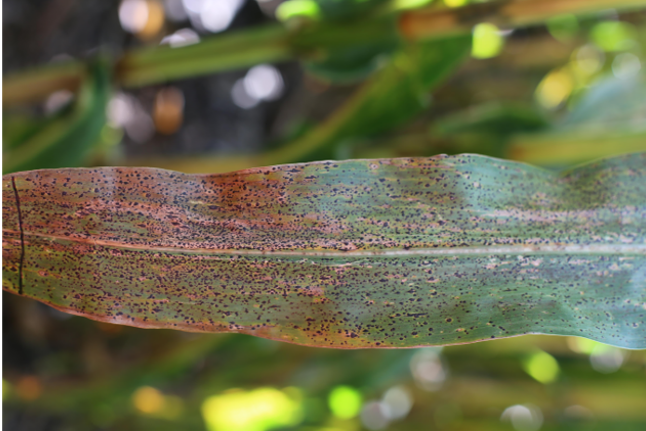
ASSEMBLING A TEAM OF FIRST RESPONDERS
The race to protect food, energy supplies and the economy from new infectious diseases such as tar spot requires an all-hands-on-deck approach, says Christian Cruz, assistant professor of botany and plant pathology.
“Purdue is well positioned to be a hub for transdisciplinary research on emerging diseases,” Cruz says. “To help prevent growers from sustaining catastrophic losses, we are challenging ourselves and our collaborators within the U.S. and overseas to act as a unified coalition.”
Together, researchers are investigating basic aspects of how the pathogen infects and the disease spreads; which fungicides help keep it at bay; promising leads on resistant corn cultivars; and data-driven approaches to describing and quantifying epidemics in a changing environment.
Telenko’s research focuses on using sustainable and economically sound approaches to plant disease management. This means fighting pathogens with multiple tools, not just chemicals, she explains.
“We use genetic resistance if we can and cultural practices such as tilling and crop rotation,” she says. “If fungicides are necessary, we want to ensure they are applied at the right time and dosage.”
Managing tar spot will require a multipronged approach. Corn hybrids in Latin America that show resistance aren’t suitable for Midwest growing conditions, and it could take a decade to produce corn cultivars that can withstand the fungus here. Purdue researchers have also shown that tar spot spores can overwinter in corn debris and aren’t fazed by a hard frost, potentially rendering tilling and crop rotation ineffective protection in this case.
“We’ve got spores moving all over with our weather system,” Telenko says. “Even if you did everything you could to try to minimize the disease in your field, it can blow in from the neighbor’s.”
Fungicides are currently the best line of defense, compounding costs for farmers, who may need to apply two rounds of spray. Telenko is also examining the potential role of irrigation in amplifying the disease, which thrives in high moisture.
Weather is a key factor driving disease severity. With a counterpart at the University of Wisconsin, Telenko helped contribute data to develop an app for growers known as Tarspotter, which uses weather data and models to predict tar spot outbreaks. “This past year, it was right on for Indiana,” she says.
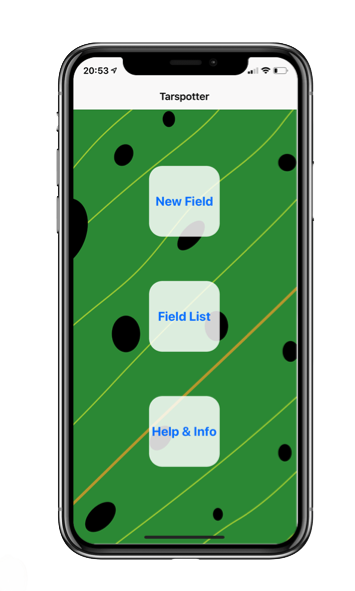
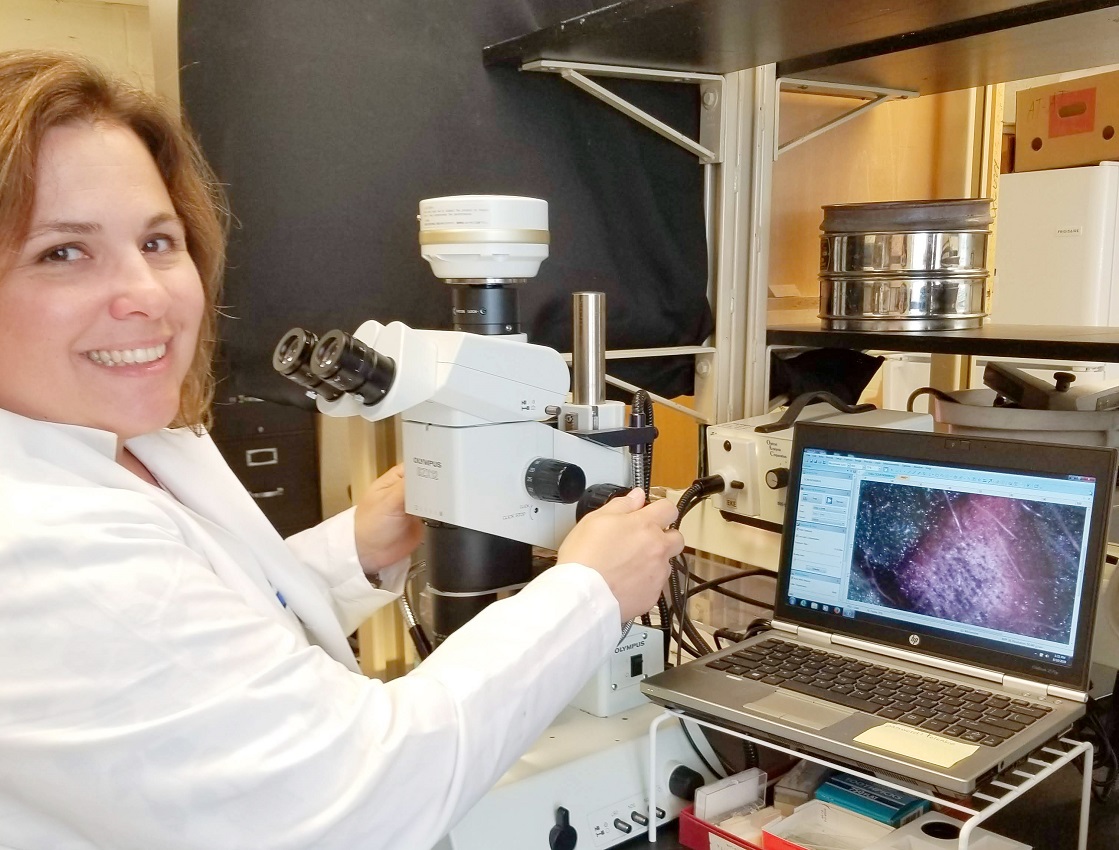
Darcy Telenko confirms and identifies field crop diseases in the lab.
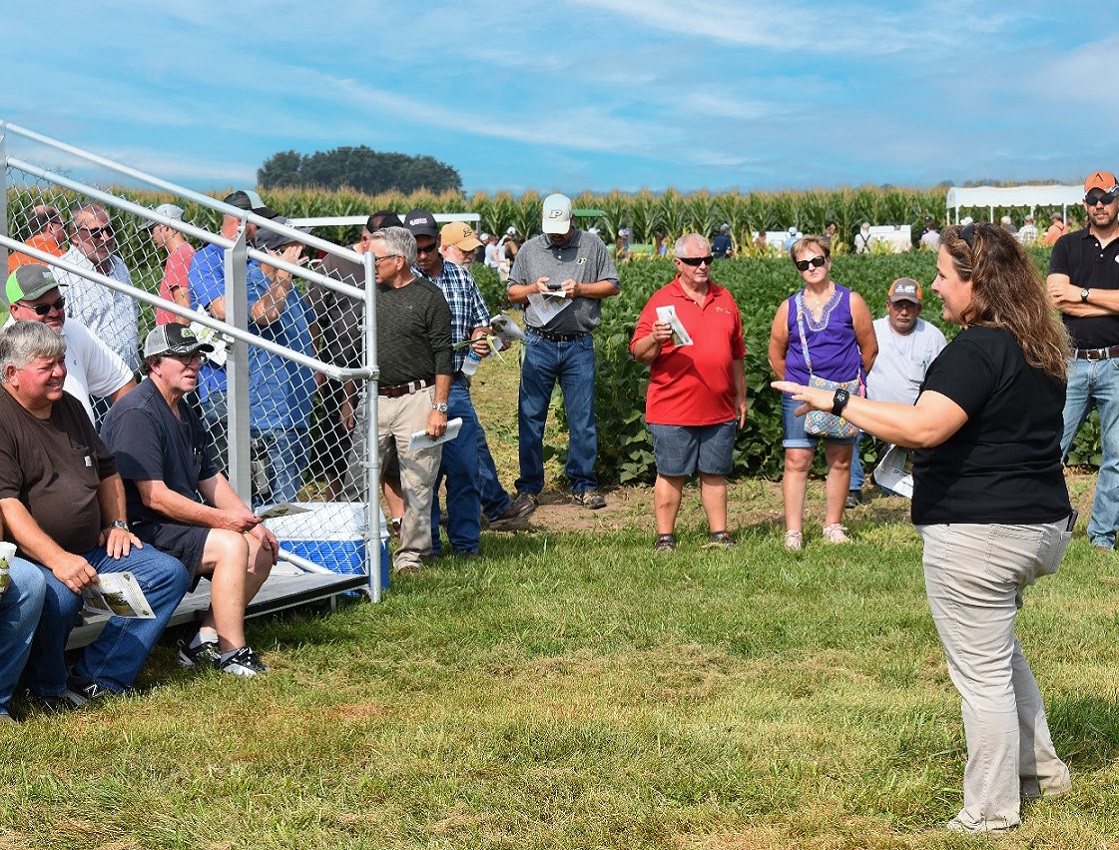
Telenko talks about tar spot and field crop disease management with growers during the 2021 Pinney Purdue Agricultural Center field day.

In the Cruz lab, Claire Schloemer (BS ’21, agronomy) identifies tar spot spores by collecting imagery with help from postdoctoral researcher Da-Young Lee.
The tar spot pathogen can only survive in its host’s living tissue. This makes it difficult to study in the laboratory because it can’t be cultured on artificial media. “That’s slowing us down tremendously,” Telenko says. “Not being able to grow it in the lab is our biggest limitation on getting information about this pathogen.”
Fortunately, Purdue has access to a consistent source of infection — the Pinney Purdue Agricultural Center 20 miles from the shore of Lake Michigan. The center's humid weather conditions produce the long periods of leaf wetness in which tar spot flourishes, making it a natural laboratory. There, Telenko and her team test fungicides and grow various corn lines to help determine which hybrids are most susceptible to infection and which show resistance. This work helps identify genes breeders can use to create new cultivars and enables Cruz and a transdisciplinary team to develop data-driven methods for disease surveillance.
The fruiting body of the tar spot fungus produces the spores that can infect plant tissue.
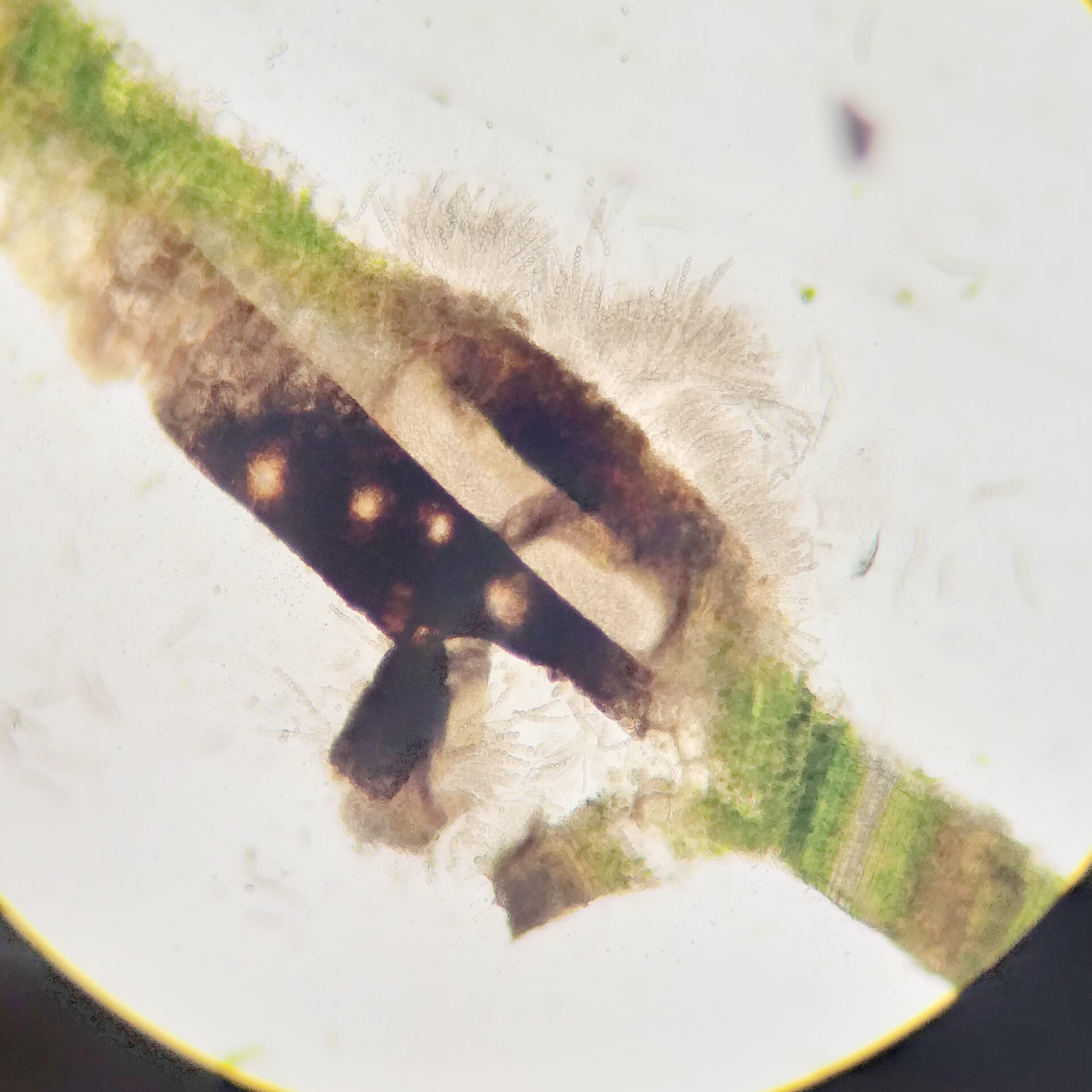
FIGHTING TAR SPOT AT THE MOLECULAR LEVEL
Combating tar spot at a microscopic scale is Steve Goodwin, U.S. Department of Agriculture-Agricultural Research Station (USDA-ARS) plant pathologist and Purdue adjunct professor. An expert on wheat diseases, Goodwin quickly pivoted when tar spot burst onto the scene, examining the genetics of both the fungal pathogen and North American corn lines.
Despite being identified more than a century ago, little is known about how tar spot enters its host plant, bypasses its defense system and infects its tissue. By the time stromata appear on a corn plant, the fungus is near the end of its life cycle. The black spots are the fungal fruiting bodies that will release spores to infect new hosts.
Telenko’s lab produced a draft genome of the fungus, which Goodwin and a team of researchers are using to identify potential effector molecules — particles involved in how tar spot interacts with its host. They’re working on attaching fluorescent tags to these molecules to watch where they go in the plant and what they do. More insight into the pathogen’s behavior could illuminate ways to combat it.
Goodwin’s lab, along with USDA-ARS research molecular biologist Raksha Singh, is also screening inbred corn lines and recently uncovered a new source of strong resistance on a chromosome not previously known to have tar spot-resistant genes. “Breeding is basically speeding up plant evolution. You’re trying to guide the plant to do something it wasn’t doing,” Goodwin says. Having several sources of genetic resistance helps stave off the pathogen’s ability to evolve a quick response.
“From what we’ve seen so far, it looks like we might be in for a rough ride,” he adds. “In plant pathology, our goal is to put ourselves out of a job. So far, the pathogens are winning.”
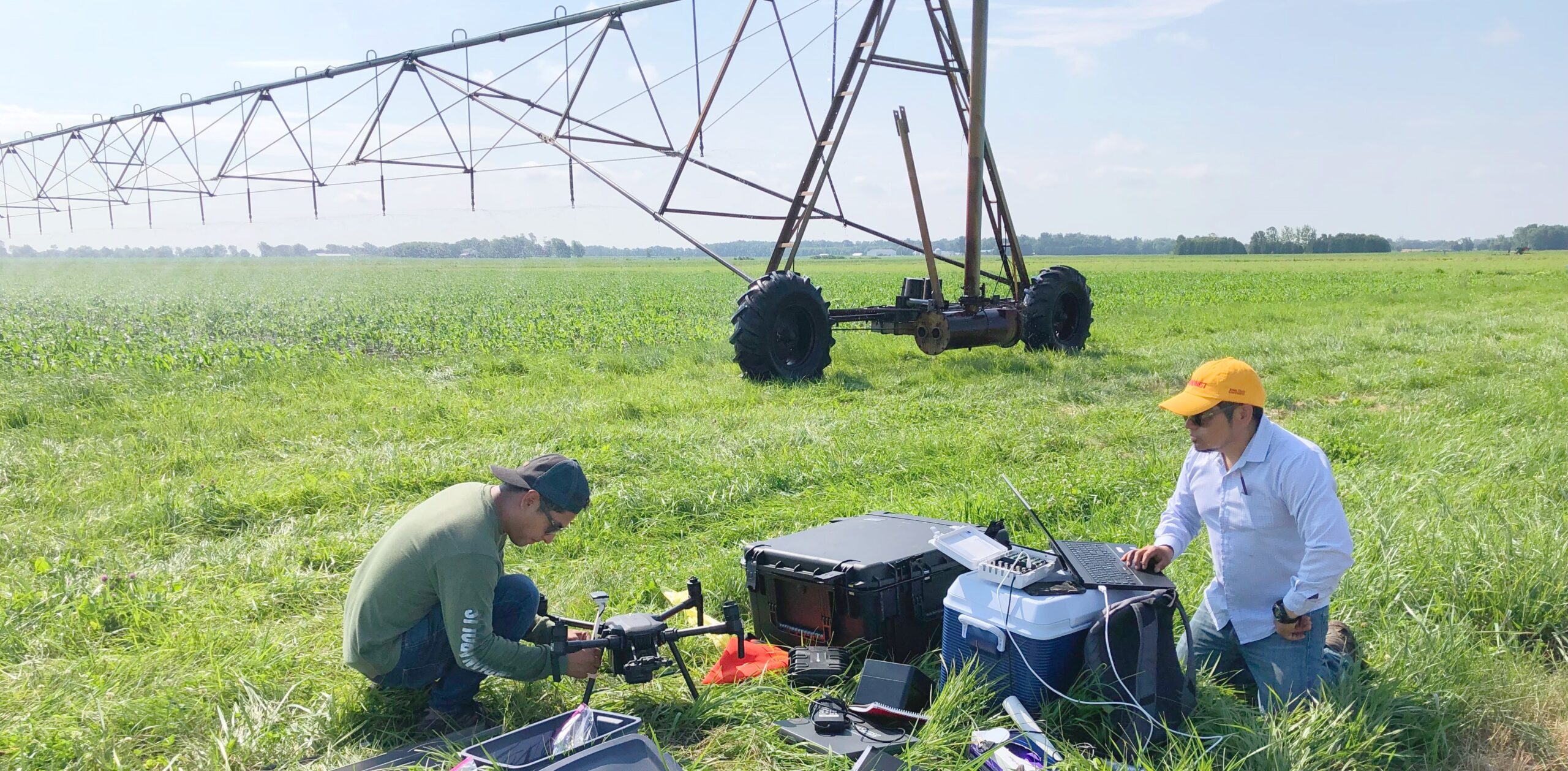
Postdoctoral researcher Carlos Gongora and lab technician Andrés Cruz prepare equipment before deploying a weather station and UAV for data collection at Pinney Purdue Agricultural Center.
DEVELOPING DATA-DRIVEN SURVEILLANCE METHODS
Plant disease epidemiologist Christian Cruz’s first job after graduating from Zamorano Pan-American Agricultural School, Latin America’s premier agrarian university, took him to the banana-growing regions of Ecuador, where he was struck by the near-constant presence of airplanes depositing plumes of pesticides to protect the crop from disease. There had to be a better way, he thought.
Today, Cruz’s research program focuses on data-driven epidemiological surveillance, examining the process by which disease spreads over time and space. He believes the key to predicting when and where plant diseases will occur, and making more precise decisions on how to manage them, lies in having more information .While the classic model of pathology is a triangle — a pathogen, host and the environment interact to produce disease — the reality is more complex, Cruz says.
As the distribution and intensity of plant diseases ramp up globally, Cruz is working to improve the efficiency of how scientists monitor crop health in the field. Current systems rely on human visual assessments, which have multiple limitations: It’s difficult for people to assess plant health over large areas or long periods of time; individual assessors may interpret what they see differently; and people can only see plant characteristics and disease symptoms that appear in the visible spectrum at a given time.
“Right now, we have a gap in the method and there is a risk of people looking in the wrong places at the wrong times,” Cruz says. “In the absence of adequate surveillance methods and data, and depending on commodity prices, growers spray fungicides whether they are needed or not.”
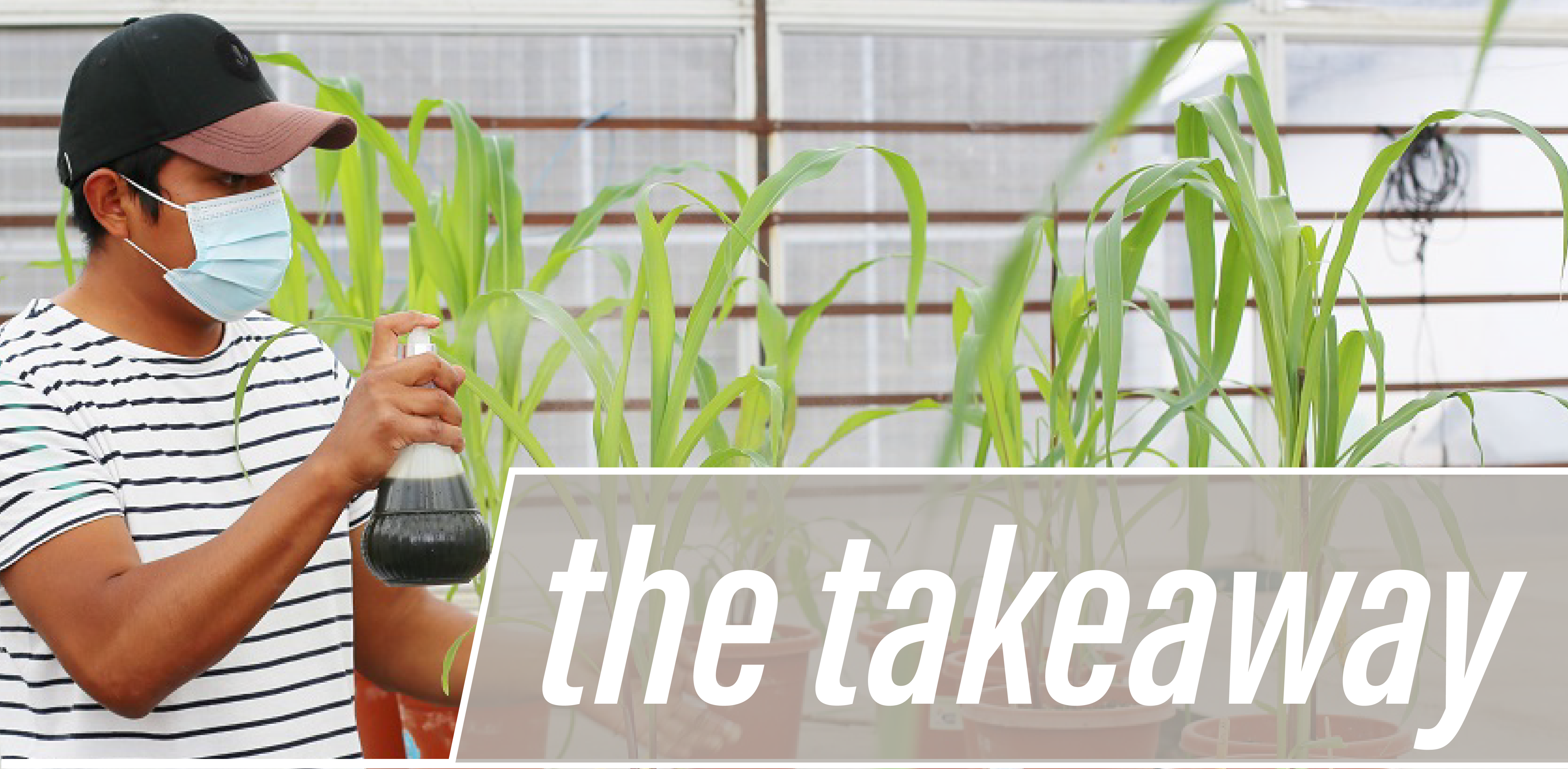
- Tar spot, a fungal disease, has emerged from the tropics to become a major threat to corn production in the U.S., including Indiana. Last year, it was the most devastating corn disease nationwide.
- A team of Purdue researchers is combating the pathogen from multiple fronts, analyzing its genetics, interactions with weather and response to fungicides, keeping Indiana growers informed of their latest research findings
- New developments point to potential sources of genetic resistance in corn, vital information for plant breeders.
- Advancements in sensing, imaging technology and data science are bringing the fight against plant diseases into a data-driven future.
- Transdisciplinary research with international collaborators is essential to fighting plant pandemics and preparing for future threats, because pathogens don’t respect borders.
Above: Tar spot can only grow in living tissue. Cruz collaborator Alex Acosta (above, at INIAP-Ecuador) works on developing an infection method to facilitate study of tar spot. Collecting samples in Ecuador from different latitudes and seasons in the same year helps Cruz’s team quickly advance potential methods to induce infection on corn leaves. These findings will help Purdue colleagues like Goodwin understand the pathogen’s infection mechanism — and eventually, ways to prevent it.
DEVELOPING DATA-DRIVEN SURVEILLANCE METHODS
Cruz and his collaborators are testing the ability of sensor-equipped drones and robots to catch signs of disease that people may miss. The goal is to combine data collected from weather stations with other types of information like imagery, the age of the crop and geolocation to get a clearer picture of how plant diseases behave across space and time: What early signs indicate a crop in distress? Where and when do symptoms first appear, and how do they spread?
Cruz and his collaborators have shown that UAV sensors can detect the amount of light reflected from leaves, one aspect impacted by disease, to provide a measure of plant health with accuracy that mirrors human visual assessments. These types of field-scale measurements could also benefit breeders, who rely on visuals to determine how experimental cultivars are responding to disease, a challenge when thousands of entries need to be analyzed.
“The more we understand these epidemics, especially their temporal and spatial dynamics, the more capacity we have to extend the durability of the tactics we use against them,” Cruz says.
Another project with postdoctoral researcher Da-Young Lee and Purdue collaborator Edward Delp, Charles William Harrison Distinguished Professor of Electrical and Computer Engineering, uses algorithms to automatically quantify the number of stromata in images of tar spot afflicted leaves. The algorithms also reveal the proportion of spots to leaf area, a proxy for disease severity.
Combining aerial and ground imagery with weather datasets gives scientists a breadth of information about all sides of the disease triangle: host, pathogen and environment, Cruz says. While these technologies are in the developmental phase, he envisions applications that could help growers develop more informed strategies for managing their crops. Advancements in imagery and machine learning technology could take the form of models that growers and decision makers can use to assess risk.
“Growers are under heavy pressure,” Cruz says. “The tools that we’re developing have the potential to help them make fast decisions with real-time data.”
WHEAT BLAST: THE NEXT BIG THREAT?
Purdue researchers remain vigilant about anticipating and preparing for future threats to crop security. Telenko works closely with the Purdue Plant and Pest Diagnostic Laboratory to monitor for diseases not yet present in Indiana, including wheat blast and red crown rot in soybeans.
Steve Goodwin, USDA plant pathologist, says the potential for fungi to exchange genes with close relatives makes it difficult to predict what kinds of diseases may emerge. “If you don’t know about it, you can’t be prepared. You just have to be ready to jump,” he says.
Cruz, who has investigated wheat blast for more than a decade, says his early work has helped researchers outline models for responding if the disease arrives in the U.S. He highlights the importance of close collaborations with grower associations, Extension crop pathologists, data scientists and statisticians, integrating activities across scientific and engineering domains.
“Protecting crops in the U.S. from threats such as wheat blast requires collaborating with the scientific community and working with stakeholders to turn the threat around,” he says. “If we help the farmers in Bolivia, Brazil, Mexico, Ecuador or other countries manage and reduce the risks associated with these diseases, we are also reducing the likelihood of pathogens or novel strains being introduced here. This is one way of being proactive.”
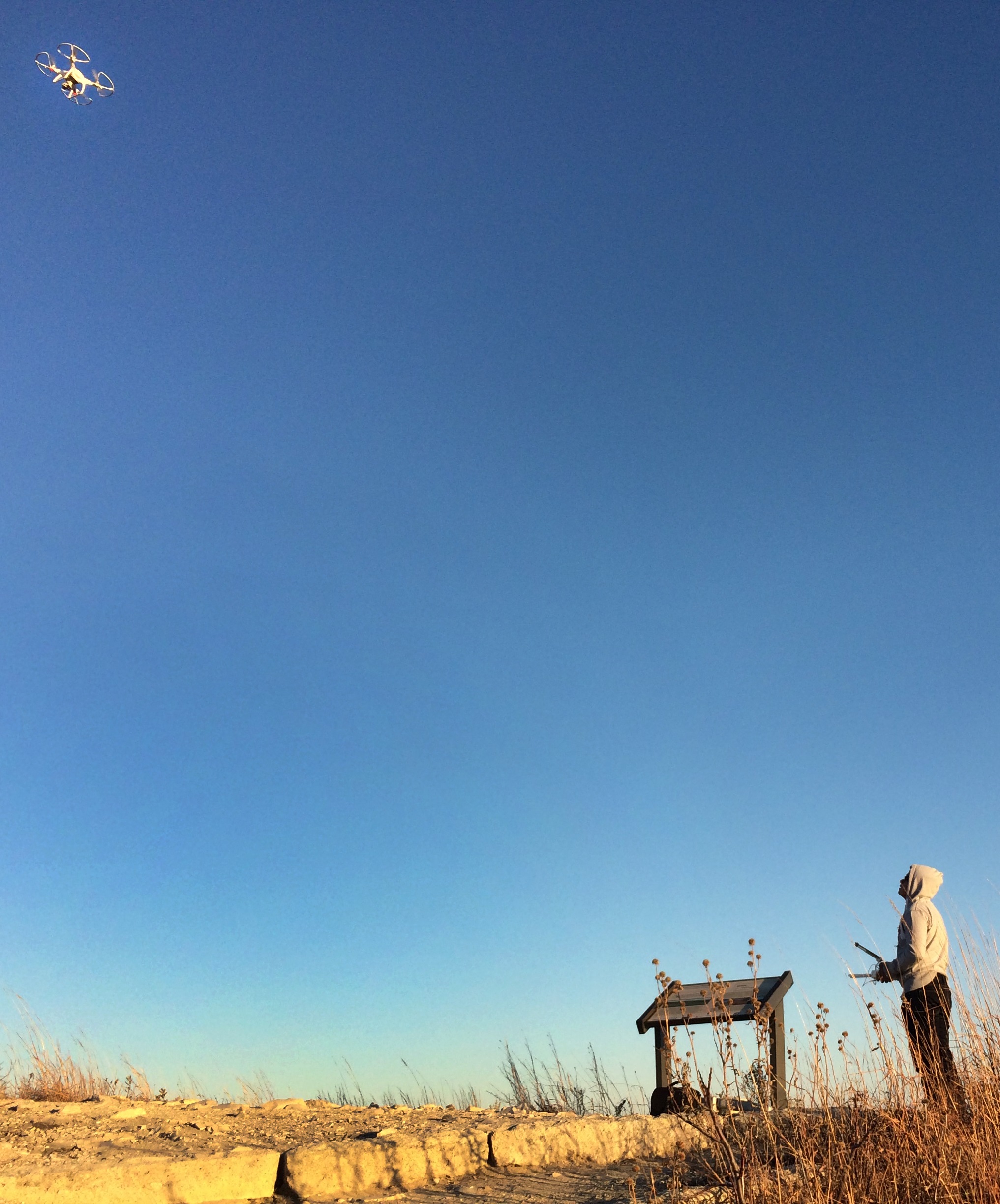
A pilot from Bolivia trains on UAV data collection in a Kansas field. Cruz says wide and international collaboration is key to reducing the spread of pathogens. His key collaborators include Mohammad Jahanshahi, associate professor of civil engineering at Purdue, as well as researchers and students from the Conkal Institute of Technology in Mexico, the National University of Colombia, Zamorano University in Honduras, the Indiana Corn Marketing Council and the Bolivian Wheat and Soybean Growers Association.
Meanwhile, in northwest Indiana, Wappel is laying out a strategy for defending his corn from tar spot in the upcoming growing season. He has planned two fungicide applications, timed according to his observations over the past four years and Telenko’s most recent data, with a third at the ready if conditions merit. For growers, change is the only constant.
“It’s just a different, unique challenge,” he says. “It’ll probably take a few more years to really figure it out, and then we’ll know exactly what to do — hopefully. Then the next thing will come.”
Purdue Agriculture, 615 Mitch Daniels Blvd, West Lafayette, IN 47907-2053 USA, (765) 494-8392
© 2024 The Trustees of Purdue University | An Equal Access/Equal Opportunity University | USDA non-discrimination statement | Integrity Statement | Copyright Complaints | Maintained by Agricultural Communications
Trouble with this page? Disability-related accessibility issue? Please contact us at ag-web-team@purdue.edu so we can help.
